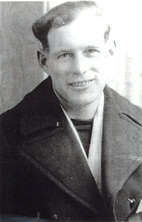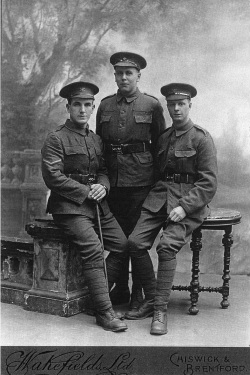 George J Furey
George J Furey I came across the mention of George Furey when I was researching the stories of Southborough & High Brooms men named on our local war memorial. One of these was Able Seaman C/SSX 15852 Reginald Nye, the son of Harry and Faith Nye, of 28 Great Brooms Road, High Brooms, Tunbridge Wells. He drowned at the age of 26 when HMS Firedrake was torpedoed while sailing as part of an Atlantic Convoy and sank on Thursday 17 December 1942. Reginald Nye is commemorated on the Chatham Naval Memorial, Kent.
The excellent website www.hmsfiredrake.co.uk, compiled by John Masters, gives extensive information on the story of HMS Firedrake, and thanks to him I was able to include a lot of
the following detail in my book Southborough War Memorial:
"Firedrake, an 'F' class Destroyer, was the escort leader to convoy ON153, with 43 ships bound for Canada. They sailed in a force 12 storm, the worst the Atlantic had seen for a very long time. At about 1700 hrs, the ASDIC operator picked up a contact. HMS Firedrake tracked the contact to about 5 miles south of the convoy, when at 2010 hrs she was hit by a torpedo fired by U-boat U211. The ship broke in two. The bow section sank immediately, with the stern just managing to stay afloat.
"Lieutenant DJ Dampier RN had a tally up and found there were 35 still on board. He quickly got the men to work shoring up the bulkheads of No. 3 boiler room, and making safe and jettisoning the depth charges and torpedoes. The gun crew were ordered to fire star shells to attract the attention of the other escorts, because all the radio and signalling equipment
had gone with the bow part of the ship.
At about 2200 hrs, one of the other escorts - HMS Sunflower, a Flower class Corvette - was attracted by the star shells so she made towards them, firing star shells herself. The skipper first thought that the stern section of Firedrake was a U-boat and was about to fire HE at it, but then suddenly realised what it was. He tried to get his ship as close as possible to HMS Firedrake in order to get the survivors off, but the weather was so bad and the sea too rough. There were 60 foot waves breaking over the two ships, which were bobbing about like corks, so he decided to stand by and hope the weather would get better. At about 0040 hrs on the 17th December, the weather worsened and the bulkheads started to give way under the tremendous battering. The stern of HMS Firedrake started to sink, so the men had no option but to take to the water, and at 0045hrs the stern sank. The Sunflower moved in quickly to pick up the men in the water; a Newfoundland rating, G J Furey, had a rope tied around his waist and was lowered down the side of Sunflower. He would swim out to a man and grab hold of him, then his mates on board would heave them back to the ship and get him on board. He and his mates managed to get 27 on board but one died later. There were 168 of the Firedrake's crew lost and three others that had been picked up earlier that had survived an earlier sinking that night."
It is hard to imagine what the experience of swimming in these seas must have been like for Furey - surely his Newfoundland upbringing must have had something to do with the incredible powers of endurance he displayed.
His son Bill and daughter Helen contacted the Firedrake Association and recalled that their father was a very strong man, and that when one of the crew of the Sunflower came to Newfoundland from England in the 1990s to visit George Furey, he was still amazed at his courage and strength after 50 years.
George died in April, 1996, at the age of 87, a very humble man from a small outpost community. He had lived a full life and raised a family of ten children. Though his children knew that he had helped save 26 men during the war, they didn't know all the details until shortly before he died. He was not one to talk about himself. He didn't see himself as a hero but talked instead about the 27th man that he couldn't hold on to, due to exhaustion. He was sorry that he couldn't have saved more.


 RSS Feed
RSS Feed
